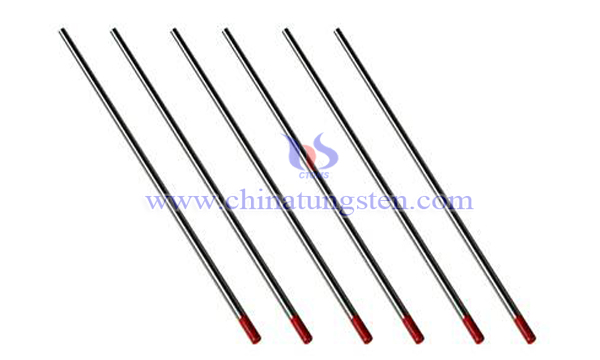Zero Radiation Multi-element Rare Earth Tungsten Electrode
- Details
- Category: Tungsten Information
- Published on Sunday, 24 March 2019 18:00
Tungsten has high melting point, strong electron emission ability, low electron escape work, high elastic modulus and low vapor pressure, so it is very suitable for non-molten argon arc welding electrode materials.

However, the high brittle-plastic transition temperature of pure tungsten makes it difficult to process and form, and the recrystallization temperature is low. Generally, the grain size of the electrode material obtained is coarse, which seriously affects the yield of production. In order to meet the higher welding technical requirements, reduce the electronic work of pure tungsten and improve its ablation resistance. Over the years, thorium has been added to tungsten metal to stimulate its electron work, which improves the welding performance of tungsten electrode, makes the arcing performance of the electrode better, the stability of the arc column higher and the burning rate of the electrode smaller.
In view of this, some researchers have tried to fabricate a zero-radiation, easy-to-process and better performance zero-radiation multi-element rare earth tungsten electrode. The principle is to make lanthanum oxide, zirconia, yttrium oxide, praseodymium oxide, rhenium and tungsten in a certain proportion. The preparation process includes the following steps:
Step 1: According to the mass percentage of lanthanum oxide, zirconia, yttrium oxide and praseodymium oxide, the content of each rare earth oxide is 0.5%-1.5%, the total amount of four rare earth oxides is 2%-3%, and rhenium is 1%-4%. The corresponding amounts of lanthanum nitrate, zirconium nitrate, yttrium nitrate, rhenium nitrate and ammonium rhenium rhenium rhenite are converted into corresponding amounts, and these compounds are then called mixed solutions.
Step 2: According to the proportion of tungsten in the material, 93-97% of tungsten is added into the above mixed solution to mix tungsten trioxide, blue tungsten, tungsten powder, or ammonium paratungstate powder of the corresponding quality, stirring evenly, heating and drying to obtain the mixed powder.
Step 3: Firstly, the above mixed powders were reduced by hydrogen in the reduction furnace at 400 ~600 C for 45 min~75 min. Then the powders were further reduced by hydrogen in the reduction furnace at 700 ~900 C for 45 min~75 min. After two reduction, the mixed powders were sifted and reserved.
Step 4: After fully mixing and homogenizing the reduced powder, weigh 500g-2500g and fill in the soft film envelope. The envelope is pressed into a cylindrical blank by cold isostatic press. The pressing pressure is set at 1000 Kg/cm2-3000 Kg/cm2.
Step 5: Pre-sintering the compacted billet under the protection of hydrogen, sintering temperature is 1100 ~1300 C, loading capacity is 5/boat~10/boat, time is 30 min~60 min;
Step 6: Put the pre-sintered billet in the vertical melting sintering equipment protected by hydrogen, keep it warm for 20 minutes under 90% of the melting current, and cool it down.
Step 7: The vertically sintered billet was forged by B203 rotary forging at temperatures of 1500 ~1650 C. After intermediate frequency induction annealing, rotary forging, wire drawing, straightening, cutting, polishing and polishing, the zero radiation multi-element rare earth tungsten electrode was obtained.
Composition design of zero-radiation multi-element rare earth tungsten electrode material fully takes into account the compound effect of multi-element rare earth oxides and alloying effect of rhenium elements, such as the solid solution softening effect of rhenium on tungsten, and the optimal combination of light rare earth elements and heavy rare earth elements is achieved for the first time by using rhenium oxide, which makes the finished product non-radiation, easy processing and better performance.
- Rare Earth Manufacturer & Supplier, Chinatungsten Online: www.chinatungsten.com
- Tungsten News & Prices of China Tungsten Industry Association: www.ctia.com.cn
- Molybdenum News & Price: news.molybdenum.com.cn
- Tel.: 86 592 5129696; Fax: 86 592 5129797; Email: sales@chinatungsten.com



 sales@chinatungsten.com
sales@chinatungsten.com